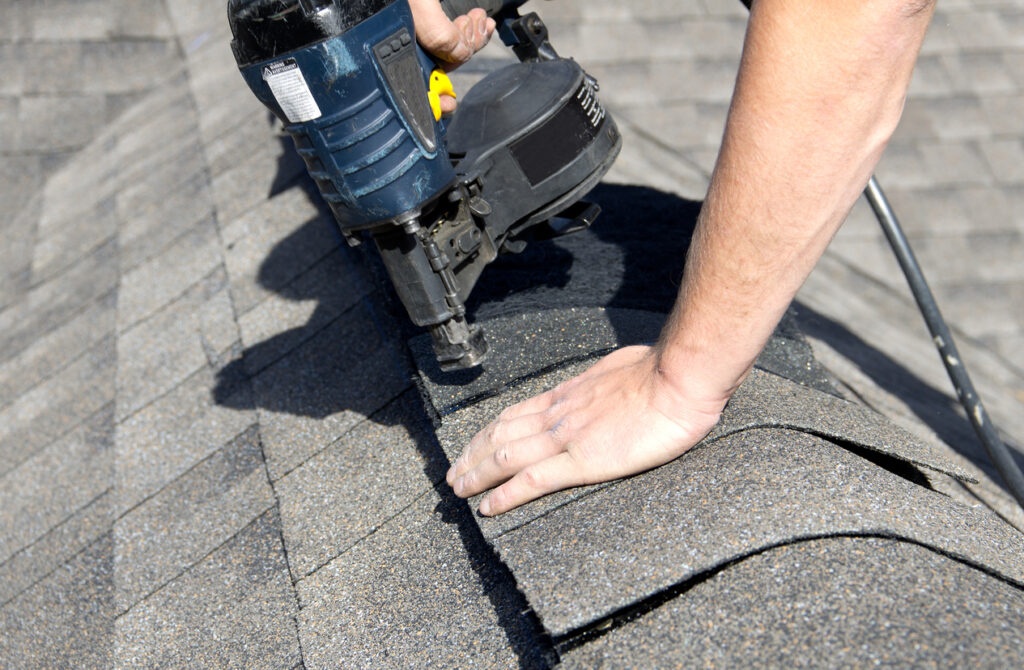Summary:
- Proper roof ventilation can extend your roof’s life by reducing moisture buildup, managing indoor temperatures, and preventing ice dams. Intake vents draw in fresh air, while exhaust vents release warm air, balancing air flow.
- Ridge, soffit, gable, and turbine vents have unique advantages. Soffit vents are low-profile, while ridge and gable vents are great for sloped or complex roofs—and turbine vents rely on wind for natural ventilation.
- Before choosing a vent, consider your attic space, climate, roof design, and style preferences. Picking the right type for your roof angle, size, and local weather conditions helps optimize ventilation.
- Consider the number of vents needed based on your attic’s square footage. Aim for about one square foot of vent per 300 square feet of space, split evenly between intake and exhaust.
- For asphalt roofs, consider Roof Maxx treatments. This plant-based solution can add up to 15 years to the lifespan of your roof.
Your roof is integral to your home, so you must take the proper steps to extend its lifespan. However, establishing how often you should replace your roof depends on several factors. For example, roof materials like asphalt last around 15-20 years. Another critical factor to consider is where you live.
Living in an area exposed to high winds and strong ultraviolet (UV) rays will reduce your roof’s lifespan. Properly ventilating your roof is a reliable way of extending its life. This raises an important question: What is roof ventilation, and what types of roof vents should you consider for your next renovation project?
Read more: Roof Vent Guide: Intake vs Exhaust Vents (& More)
What Is Roof Ventilation?
Roof ventilation is a system allowing air to circulate freely through your attic space and roof vents. The vent design preserves your home in various ways, including:
- Keeping your home from overheating
- Preventing moisture buildup
- Minimizing ice dams
- Regulating indoor temperatures
- Reducing your energy bill
- Protecting your home from fungi
- Preventing condensation
Think of roof ventilation as a long-term home preservation solution, protecting homeowners from extreme weather conditions. For example, in the summer, your vents clear the hot air from the attic. In the winter, these vents help maintain your attic at a consistent temperature, preventing snow from repeatedly thawing and freezing on your roof and forming ice dams.
How Does Roof Ventilation Work?
So how exactly does the process work? Several roof ventilation options can give your home the best air circulation and ventilation. Roof ventilation involves vent installation at certain spots on your roof. For air to flow, you need one of two primary power methods:
- Mechanical: This ventilation type relies on a power source for proper air circulation. If you live in an area with little to no wind speed, you’ll have to rely on a mechanical source to increase the ventilation in your home.
- Natural: With natural ventilation, you rely on outside and inside air pressure differences to provide proper roof ventilation. Your roof vents serve as outlets for hot air to escape while keeping the inside of your home nice and cool.
Different Ventilation Types (Intake and Exhaust)
Remember that not all roof ventilation systems are designed alike. Some vent designs draw in air from the outside, while others expel warm air. Let’s expand on the differences between intake and exhaust vents so you can decide on your next renovation project.
Exhaust Vents
An exhaust vent prevents hot air from circulating around your attic by releasing it outside. Since hot air holds moisture that can result in mold, exhaust vents expel substances that can damage your roof or other sections of your home. The key to increasing ventilation efficiency is to spread exhaust vents across your structure.
Intake Vents
As the name suggests, intake vents draw in air from the outside to establish an indoor climate area ideal for a living environment. In a way, intake vents operate as a two-way system. As cooler air enters through your vents at the bottom of the roof, it continuously flows through the attic before being released through your exhaust vents at the top.
Signs of Poor Ventilation
Unfortunately, some homeowners don’t take the time to assess the condition of their attic vents. Without a proper inspection, you run the risk of high costs associated with repairs and replacements. Here are some warning signs your attic has poor ventilation:
- Ice dams form on your roof.
- Roofing materials deteriorate.
- Mold builds up on the underside of your roof.
- The attic traps large amounts of heat.
- Moisture forms on ceiling joists.
- Your roof shows signs of sagging.
- The shingles become loose.
- Air is unable to circulate through your home.
- Pests make their way into your vents.
- Your electricity bill increases.
Type of Roof Vents to Consider
The first thing you should understand about the different types of roof vents is that no option stands above others. You must customize your system to your property and account for various external conditions impacting the roof’s lifespan, including your area’s climate. Here are the different types of vents used for ventilation:
1. Ridge Vents
What’s great about ridge vents is that they center on the highest point of your roof, allowing hot air to escape your attic. Most ridge vents are easy to install, making them suitable for homeowners wanting an external setup without labor complications. They also run across the entire span of your roof line.
Ridge vents are designed to resist rain, snow, and debris that accumulate from extreme weather conditions.
2. Off-Ridge Vents
Off-ridge vents are located near the crest of your roof. These vents work best for roofs with a small surface area. The material comprises galvanized steel—standard steel coated in zinc to provide corrosion resistance. Unfortunately, their small size prohibits them from expelling large amounts of hot air.
However, off-ridge vents work wonders for homes with a complex design and no ridge crossing the entire roof.
3. Box Vents (Louver Vents)
Box vents are square-shaped designs distributed across your roof. Like off-ridge vents, box vents work best for roofs with complex structures. Standard box vents are usually 18 x 18 inches. When placed across the surface of your roof, box vents allow hot air and moisture to escape from the interior.
4. Hard-Wired Powered Attic Vents
Also known as powered attic ventilators, hard-wired vents are circular components relying on motorized fans to suck hot air beneath the roof deck. These vents also use electricity to remove hot air from your attic while keeping your attic at a constant temperature. The downside of using them is that they can sometimes circulate unwanted air instead of expelling it.
5. Solar-Powered Vents
The great thing about solar-powered vents is that they can remove almost all of the electricity expenditures caused by inefficient vents. As the name suggests, solar-powered systems rely on energy provided by the sun, so they’re not ideal if you live in conditions where sunlight is rare. The dependence on sunlight could make it challenging to keep your roof properly ventilated.
6. Roof Turbines
Roof turbines rely on wind to pull air out of your attic and reduce the risk of mold. Without wind, the interior blades won’t spin. Since the wind does the hard work for you, you don’t need electricity to keep them operational. Turbines are smaller than box vents, so you’ll need to install several for efficient attic ventilation.
7. Cupola Vents
Cupola vents come in different shapes, including square, round, and octagonal. The primary purpose of these vents is to allow extra light underneath the vents. Cupolas usually have one of two styles for venting your structure: louvers and windows.
- Louvers have angled strips allowing circulation around your home.
- Windows provide the same benefits but contain small glass panes that can be opened and closed.
8. Soffit Vents
Soffit vents are devices installed under your roof’s eaves—the section extending past the exterior siding. These vents create an airflow that circulates throughout your attic. Some soffit devices run the entire length of the roof edges, while others are spaced out from each other.
What makes soffit vents beneficial is that they operate simply without sacrificing effectiveness. They’re also great for prolonging the stability of your A/C system.
9. Gable Vents
Gable vents are installed on different sides of a house wall instead of on the roof. Their primary design is to provide cross ventilation to keep air moving throughout your attic space.
Most gable vents work well with gable-style roofs because you can place them on each side of your home. These vents come in all shapes and sizes, including triangular shapes.
10. Over-Fascia Vents
In situations where the wind impacts the roof, over-fascia vents facilitate air intake. In this case, shingles cover the top of the vent. Over-fascia vents can ventilate your roof and attic if your roof lacks space for soffit vents. The holes on the edges of these vents allow air to enter under the roof.
11. Drip Edge Vents
Drip edge vents include roofing material that goes underneath your roof’s shingles. Their purpose is to help drain water into the gutters. The material used to design the vent is a malleable metal—a material that can deform under compressive stress. Drip edge vent design may include holes on the sides.
12. Dormer Vents
Like other vents listed here, dormer vents facilitate heat expulsion. They also include a small screen between their louvers, preventing pests from entering through the vents. Since the product can match the color of your roof, dormer vents are a solid selection if you want something stylish and aesthetically pleasing.
13. Hip Vents
The unique thing about hip vents is that they resemble a pyramid-like structure. These vents attach to your hip roofs—where all roof sides face downward toward the walls. Contractors generally cover these with shingles. Finally, hip vents can be the right choice for homeowners wanting a vent that blends well with the design of their home.
14. Felt Lap Vent
While they’re not a popular selection, felt lap vents are handy if you live on a property with poor ventilation or that is susceptible to condensation. These vents are most commonly used on roofs with waterproofing layers and can increase ventilation in existing roof spaces.
You can also use felt lap vents to bring air flow to your roof to remove any moisture that forms.
15. Dry Ridge Vent
Dry ridge vents (dry ridge systems) are helpful because they require few materials for proper assembly. While initially designed to fix ridge tiles, these vents provide discrete ventilation.
Homeowners can avoid harmful bacteria buildup using these vents. The best part is that the vents withstand strong winds and won’t blow off on a windy day.
What Type of Roof Venting Is Best for My Home?
Becoming familiar with the types of roof vents available is the first step in your ventilation project. The next step is determining which type is best suited for your roof. As mentioned earlier, there’s no option above all others. Every home is different, conditions change, and your roof may require specific materials for proper ventilation.
However, there are effective strategies you can take to determine the best solution for your home project. Here are five questions to consider before deciding on a roof vent:
1. How Much Space Do You Need?
Determine how much space you’ll need to set up a proper ventilation system to circulate air throughout your attic and roof. You can accurately measure by determining the width and length of your attic floor. These numbers should provide you with accurate square footage.
Once you get the number, divide the square footage by 300 to ensure you receive one square foot of ventilation for every 300 square feet of attic floor space.
2. What Type of Climate Do You Live In?
Your area’s climate can make all the difference between durable vents that extend your roof’s lifespan and insufficient products resulting in high replacement costs. For example, if you live where snow storms are common, consider turbine vents since they can protrude above accumulated snow.
If you live in a high-humidity area, your safest bet would be a soffit vent. These vents help reduce humidity levels in regions with high moisture concentrations.
3. How Much Do You Want to Alter the Look of Your Roof?
Some homeowners are extremely picky about the look and style of their roofs, and they don’t want to change anything compromising the roof’s aesthetics. In this case, select soffit vents. Since you can install these on the underside of porches, columns, or arches, they won’t alter the look of your roof.
Plus, soffit vents come in various colors and can resemble your exterior siding.
4. What Is Your Roof’s Angle?
Remember earlier when we said some vents work best for roofs with complex designs? Use this principle to determine the best vent for achieving optimal airflow. If you have a pitched roof, go with ridge vents which can increase air intake along your roof line.
If you have a flat roof, consider installing soffit vents. These vents can run the entire length of your roof from one edge to the other while providing additional ventilation.
Remember: The taller your roof’s peak, the taller you’ll want your roof vents to be.
5. Determine the Number of Required Vents
Take time to thoroughly assess how many roof vents you must install. The correct number of vents helps prevent moisture accumulation. As we mentioned, the rule of thumb is to have one square foot of roof vent for every 300 square feet of roof surface.
Another recommended guideline involves having an equal amount of air intake and exhaust vents. With an equal distribution of intake and exhaust vents on your roof, you can control indoor temperature and moisture in the attic.
Your roof deserves the best care it can get. By learning about all the different types of roof vents available, you’ll discover ways to increase your roof’s lifespan, choose the proper ventilation option for your home, and make your living space comfortable.
Extend Your Roof’s Life with Roof Maxx
As a final note, if you have an asphalt shingle roof, Roof Maxx professionals can extend its lifespan by up to 15 years through our treatment process.
Get in touch with us to learn more about our offers.





